Directions (1-5): Find the wrong number in the following number series.
Q1. 8, 10, 20, 70, 320, 1570, 7830
(a) 7830
(b) 10
(c) 8
(d) 320
(e) 1570
Q2. 18, 20 , 43, 133, 537, 2691, 16163
(a) 43
(b) 16163
(c) 133
(d) 537
(e) 2691
Q3. 124, 140, 108, 156, 92, 172, 78
(a) 108
(b) 124
(c) 78
(d) 92
(e) 140
Q4. 260, 380, 510, 618, 759, 856, 1008
(a) 759
(b) 1008
(c) 260
(d) 510
(e) 618
Q5. 267, 343, 610, 953, 1563, 2515, 4079
(a) 4079
(b) 953
(c) 343
(d) 267
(e) 2515
Q6. Ratio of present age of A to that of B is 2 : 5, ratio of present age of B to that of C is 25 : 18 and ratio of present age of C to that of D is 12 : 13. If D is 11 years younger than B, then find present age of A.
(a) 24 years
(b) 20 years
(c) 28 years
(d) 30 years
(e) 18 years
Q7. Perimeter of a right-angled triangle is 60m and length of hypotenuse of right-angled triangle is 25m. If base of the right-angled triangle is the smallest side, then find length of smallest side.
(a) 10m
(b) 18m
(c) 21m
(d) 25m
(e) 15m
Q8. Shopkeeper sells two articles – M & N. He marks article – M 20% above its cost price and he gave 5% discount on it. Cost price of article – N is 20% more than cost price of article – M. If shopkeeper sold article – M at Rs.285 and article – N at 15% profit, then find selling price of article – N.
(a) Rs.345
(b) Rs.230
(c) Rs.460
(d) Rs.414
(e) Rs.322
Directions (9-13): The following questions are accompanied by two statements (I) and (II). You have to determine which statements(s) is/are sufficient/necessary to answer the questions.
Q9. Let t be total number of balls in a bag. Balls are of 3 colors – black, white and red. Find t.
(I) when one ball is drawn then Probability of getting a black ball is 1/6, a red ball is 1/6 & a white ball is 2/3.
(II) If one white ball is lost and a ball is drawn, then probability of not getting a white ball is 8/23.
(a) Statement (I) alone is sufficient to answer the question but statement (II) alone is not sufficient to answer the question.
(b) Statement (II) alone is sufficient to answer the question but statement (I) alone is not sufficient to answer the question.
(c) Both the statements taken together are necessary to answer the question, but neither of the statements alone is sufficient to answer the question.
(d) Either statement (I) or statement (II) by itself is sufficient to answer the question.
(e) Statements (I) and (II) taken together are not sufficient to answer the question.
Q10. Shivam and Deepak invested in a partnership business in the ratio of 4 : 5. Find the profit share of Shivam.
(I) Shivam invested Rs.12000 and period of investment of Shivam and Deepak is 10 months and 4 months respectively.
(II) Ratio of period of investment of Shivam and Deepak is 5 : 2 and Deepak’s profit share is Rs.12000 less than Shivam’s profit share.
(a) Statement (I) alone is sufficient to answer the question but statement (II) alone is not sufficient to answer the question.
(b) Statement (II) alone is sufficient to answer the question but statement (I) alone is not sufficient to answer the question.
(c) Both the statements taken together are necessary to answer the question, but neither of the statements alone is sufficient to answer the question.
(d) Either statement (I) or statement (II) by itself is sufficient to answer the question.
(e) Statements (I) and (II) taken together are not sufficient to answer the question.
Q11. Calculate the marked price of item?
(I) Shopkeeper marked the article 80% above its cost price and shopkeeper earned Rs.100 profit on the article.
(II) Ratio of marked price and discount allowed on the article is 3 : 1.
(a) Statement (I) alone is sufficient to answer the question but statement (II) alone is not sufficient to answer the question.
(b) Statement (II) alone is sufficient to answer the question but statement (I) alone is not sufficient to answer the question.
(c) Both the statements taken together are necessary to answer the question, but neither of the statements alone is sufficient to answer the question.
(d) Either statement (I) or statement (II) by itself is sufficient to answer the question.
(e) Statements (I) and (II) taken together are not sufficient to answer the question.
Q12. Calculate the rate of interest.
(I) Pankaj earned Rs.4500 as interest, when he invested Rs.6000.
(II) Pankaj invested equal amount at SI and at CI. After 2 years, CI received by Pankaj is Rs.90 more than the SI received by Pankaj.
(a) Statement (I) alone is sufficient to answer the question but statement (II) alone is not sufficient to answer the question.
(b) Statement (II) alone is sufficient to answer the question but statement (I) alone is not sufficient to answer the question.
(c) Both the statements taken together are necessary to answer the question, but neither of the statements alone is sufficient to answer the question.
(d) Either statement (I) or statement (II) by itself is sufficient to answer the question.
(e) Statements (I) and (II) taken together are not sufficient to answer the question.
Q13. Find the volume of cylinder.
(I) Curved surface area of cylinder is 1760 cm2 and total surface area of cylinder is 70% more than its curved surface area.
(II) Volume of cylinder is twice of that of cone. Radius of cylinder and cone is equal and ratio of height of cylinder to that of cone is 2 : 3. Height of cone is 30 cm.
(a) Statement (I) alone is sufficient to answer the question but statement (II) alone is not sufficient to answer the question.
(b) Statement (II) alone is sufficient to answer the question but statement (I) alone is not sufficient to answer the question.
(c) Both the statements taken together are necessary to answer the question, but neither of the statements alone is sufficient to answer the question.
(d) Either statement (I) or statement (II) by itself is sufficient to answer the question.
(e) Statements (I) and (II) taken together are not sufficient to answer the question.
Q14. Ayush invested Rs.75000 in a scheme offering R% p.a. SI for 5 years and Rs.50000 in another scheme offering 12%p.a. CI compounding annually for 2 years. If difference in 2nd year CI and 2nd year SI is Rs.2220, then find value of R%.
(a) 4%
(b) 8%
(c) 6%
(d) 12%
(e) 14%
Q15. Train – Y crosses Train – X while running in same direction in 120 seconds and Train – Y crosses Train – X in 40/3 seconds while running in opposite direction. If Train – X is running at 120 km/hr, then find speed of Train – Y (in km/hr).
(a) 150
(b) 180
(c) 200
(d) 160
(e) None of the above.
Practice More Questions of Quantitative Aptitude for Competitive Exams:
Solutions
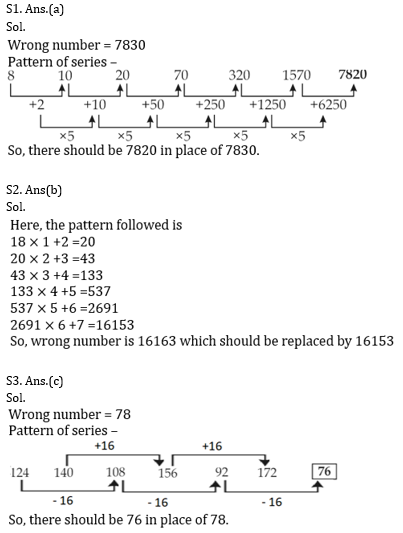
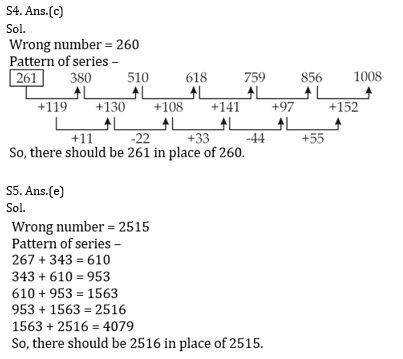
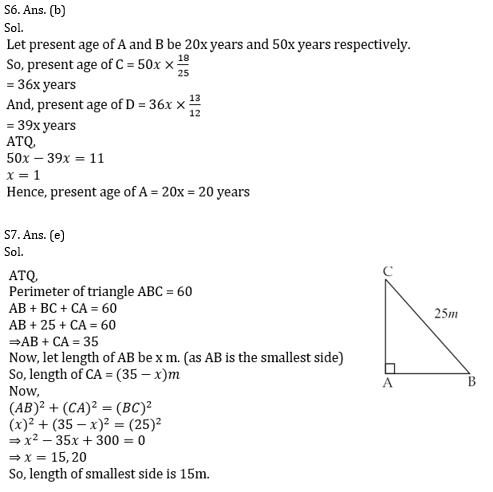
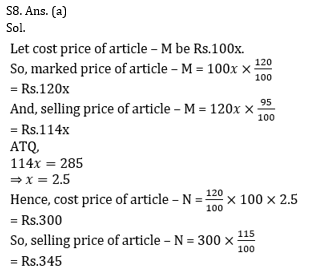
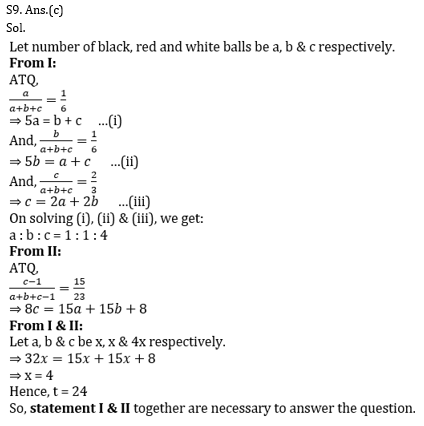
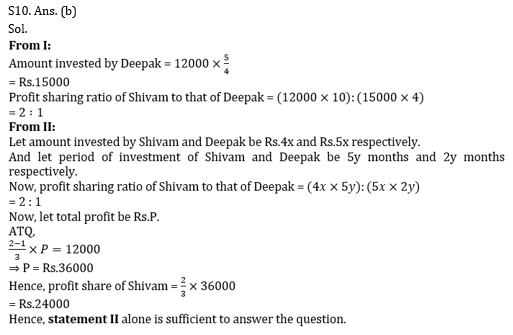
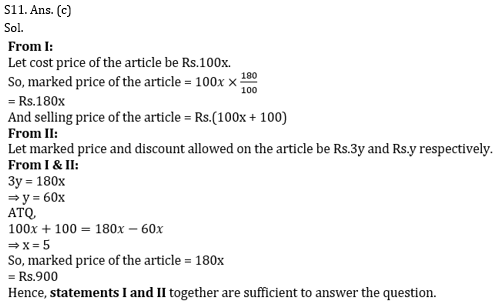
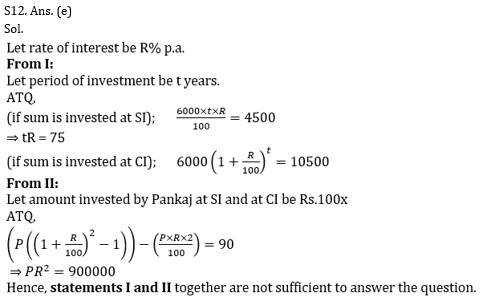
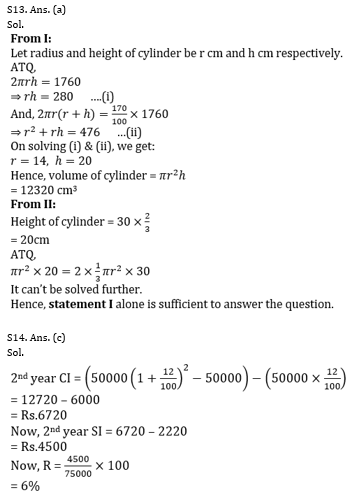
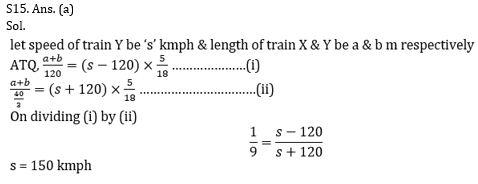
Practice with Crash Course and Online Test Series for IBPS PO/RBI Assistant 2020:
- RBI Assistant Mains 2020 Online Test Series
- IBPS PO Online test series (Prelims + Mains) 2020 by Adda247
- IBPS KA MAHAPACK Online Live Classes

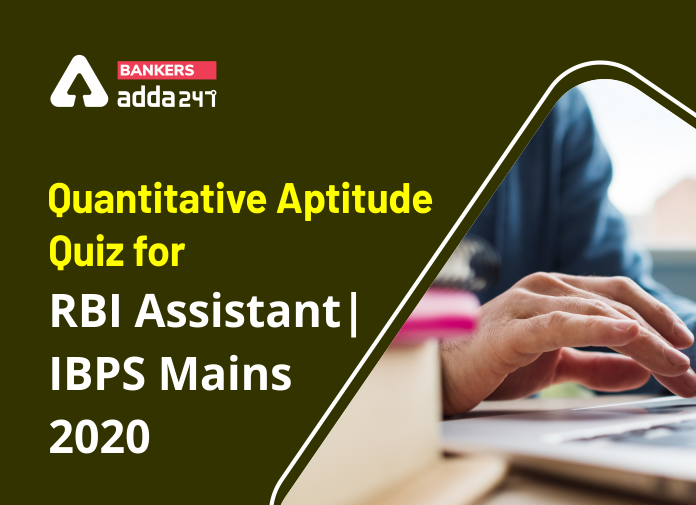


 50+ Data Sufficiency Questions For Bank ...
50+ Data Sufficiency Questions For Bank ...
 Quantitative Aptitude Quiz For Bank Main...
Quantitative Aptitude Quiz For Bank Main...





